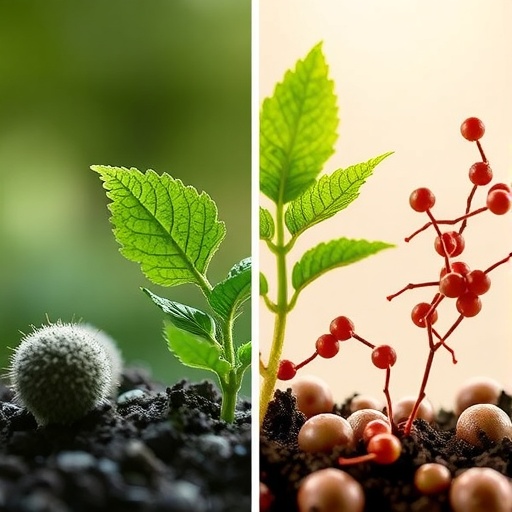In a groundbreaking study published in Environmental Science and Pollution Research, researchers Shi, Lu, Yang, and colleagues have embarked on a comprehensive meta-analysis focused on the uptake of heavy metals—copper (Cu), nickel (Ni), cadmium (Cd), zinc (Zn), and arsenic (As)—by various plant species. The significance of this research lies not only in its environmental implications but also in the methods employed to enhance nutrient uptake through microbial inoculation, specifically with bacteria from the genera Pseudomonas and Bacillus. This exploration is critical as it directly relates to phytoremediation strategies and ecological rehabilitation in contaminated environments.
Phytoremediation is a process that utilizes plants to extract, stabilize, or degrade environmental pollutants, effectively using nature’s own mechanisms to mitigate contamination. The presence of heavy metals in soil and water is a significant environmental concern, posing risks to human health and ecosystems. By understanding how different plants interact with these metals, researchers aim to develop better strategies for utilizing flora in the cleanup of polluted sites. This study presents compelling insights derived from various experiments and data sets focusing on the influence of microbial inoculation on metal uptake.
The researchers highlighted that both Pseudomonas and Bacillus have been recognized for their roles in enhancing plant growth, nutrient uptake, and stress resistance. Specific strains possess distinct characteristics that can alter plant-microbe interactions. The meta-analysis compiled numerous studies, analyzing factors such as bacterial strain, metal type, plant species, and growth conditions, to draw broader conclusions about effective inoculation practices. This information is vital for developing tailored bioremediation techniques that can address specific contaminants in various environmental contexts.
The comparative approach utilized in this research has given rise to significant revelations regarding the differential absorption capabilities of plants when inoculated with these bacteria. Treated plants exhibited higher concentrations of heavy metals, specifically in their shoots and roots. This outcome suggests that microbial inoculation can enhance the bioavailability of these metals, leading to a more effective uptake process, which is essential for achieving the goals of phytoremediation. The study further underscores the importance of selecting appropriate combinations of bacterial strains and plant species to optimize this process.
Moreover, the researchers meticulously examined the effects of environmental variables such as soil type, pH, and moisture content on metal uptake. These parameters can significantly influence the efficiency of plant-microbe interactions and, consequently, the overall effectiveness of phytoremediation efforts. The findings indicate that soil amendments and microbial inoculation, when applied strategically, can drastically improve the growth responses of plants in contaminated soils, even under varying environmental conditions.
As urban and agricultural areas become increasingly polluted, the demand for efficient methods of remediating contaminated sites is on the rise. This study’s findings suggest that employing a combined strategy of microbial inoculation and careful selection of plant species can provide a sustainable solution for mitigating heavy metal pollution. Furthermore, the potential for utilizing this approach in bioremediation scenarios presents an exciting opportunity for integrating ecological health into urban planning and agricultural practices.
In today’s age of climate change and environmental degradation, revisiting traditional methods of pollution control through innovative scientific strategies is essential. The role of microbes in supporting plant health and enhancing metal uptake provides new avenues for research and development in the realm of environmental restoration. The researchers hope that their work will encourage further investigations into microbial interactions and their potential for shaping plant responses to environmental stressors.
Public awareness and acceptance of phytoremediation techniques are crucial for their implementation. Highlighting the environmental benefits and ecological resilience obtained through strategies outlined in this study could help foster a more environmentally conscious public. As the field of environmental science continues to advance, studies like this will form the backbone upon which future research and remediation practices will be built.
Additionally, the implications for agricultural practices cannot be overstated. With heavy metal contamination increasingly affecting crop production, integrating microbial inoculation with phytoremediation methods could foster the revival of contaminated lands through sustainable agricultural techniques. This, in turn, could lead to improved food security and public health outcomes as contaminated soils are rehabilitated for safe cultivation.
In conclusion, the discoveries articulated in this comparative meta-analysis pave the way for a deeper understanding of how plant-microbe interactions can be harnessed for environmental remediation. The nuances of metal uptake facilitated by Pseudomonas and Bacillus offer promising perspectives on developing effective strategies to address heavy metal contamination. It is expected that the implications of this research will resonate across both environmental science and agricultural communities, positioning these findings as the foundation for growing interdisciplinary collaboration.
This study clearly delineates a path forward in combating the pressing environmental issues rooted in heavy metal pollution. The confluence of plant biology, microbiology, and environmental science encapsulated in this research serves as a reminder of the intricate relationships that maintain ecological balance. As further studies emerge, the collective knowledge gained will undoubtedly empower a new era of sustainable remediation practices.
Ultimately, the synergy created between microbial inoculation and plant uptake presents an ingenious solution to long-term ecological challenges. As communities around the globe grapple with pollution, the insights garnered from this meta-analysis may serve as essential tools in guiding future efforts toward healthier ecosystems and a cleaner world.
Subject of Research: Heavy metal uptake by plants through microbial inoculation
Article Title: A comparative meta-analysis of Cu, Ni, Cd, Zn, and As uptake by plants after inoculation with Pseudomonas or Bacillus.
Article References:
Shi, B., Lu, M., Yang, R. et al. A comparative meta-analysis of Cu, Ni, Cd, Zn, and As uptake by plants after inoculation with Pseudomonas or Bacillus. Environ Sci Pollut Res (2025). https://doi.org/10.1007/s11356-025-37246-x
Image Credits: AI Generated
DOI: https://doi.org/10.1007/s11356-025-37246-x
Keywords: Heavy metals, Phytoremediation, Pseudomonas, Bacillus, Metal uptake, Environmental science.




